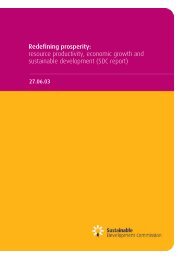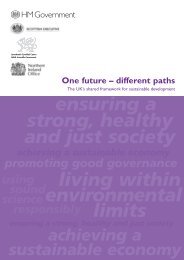Every Child's Future Matters - Sustainable Development Commission
Every Child's Future Matters - Sustainable Development Commission
Every Child's Future Matters - Sustainable Development Commission
You also want an ePaper? Increase the reach of your titles
YUMPU automatically turns print PDFs into web optimized ePapers that Google loves.
Foreword<br />
Children are at the heart of many of our society’s<br />
aspirations and it’s clear that when we try we can<br />
get a lot right. The Government’s decision to focus on<br />
children’s wellbeing in <strong>Every</strong> Child <strong>Matters</strong> is a good<br />
one. Yet when we take our focus away from the things<br />
we do directly for children and look at the wider<br />
picture it’s clear that many children are expected<br />
to live in polluted, noisy, concrete environments.<br />
We chip away at our green spaces and consume<br />
natural resources to the point where we threaten<br />
our own existence. What would our neighbourhoods,<br />
transport choices and environmental policies look<br />
like if they took children’s wellbeing – both now and<br />
in the future – as their starting point?<br />
These concerns are not some kind of sideshow<br />
to children’s wellbeing; they are critical features of<br />
a good childhood. And yet the majority of Children<br />
and Young People’s Plans contain scant reference<br />
to the environment. When it comes to listening and<br />
responding to young people’s views about their<br />
needs, we have to start by asking them the right<br />
questions. Not just what facilities they would like<br />
to see provided for their recreation, but what they<br />
think is wrong and right about their communities at<br />
a fundamental level, and what they would like to<br />
see change.<br />
At the heart of this debate is a major social<br />
justice issue among and between generations.<br />
The poorest and most vulnerable people are the<br />
ones who suffer most and first from the destruction<br />
of the environment. For example, destruction of<br />
green and open spaces in inner cities removes<br />
what are often the only places for children and<br />
young people from disadvantaged communities to<br />
play outdoors. Similarly, we recognise the right of<br />
children to a safe, healthy, enjoyable and rewarding<br />
present – but are we acting to protect that quality of<br />
life in future? Climate change stands in the way of<br />
this at present. It has the capacity to destabilise the<br />
economy here and overseas, producing upheaval,<br />
insecurity and poverty as well as incalculable<br />
environmental damage.<br />
Our challenge is to extend the horizons of<br />
children’s policy beyond the present social and<br />
economic focus to embrace the environment as a key<br />
factor in wellbeing. Local authorities in their role as<br />
place-shapers and strategic champions for children<br />
and young people have a singular opportunity<br />
to lead this change, but they need concerted<br />
support and coordination from central government.<br />
We must do this today for all children, and we must<br />
ensure that children are being empowered to do<br />
this themselves through schools, youth services and<br />
community projects.<br />
Bringing social, economic and environmental<br />
factors together in this way is the basis of sustainable<br />
development, a core UK Government aim. It is a<br />
necessary part of building a society that cares for its<br />
children. It should be one of our core values.<br />
We owe it to children and young people to allow<br />
them a healthy and sustainable future. They will not<br />
easily forgive us if we continue to squander their<br />
environmental inheritance.<br />
Waheed Saleem<br />
<strong>Commission</strong>er for Young People<br />
Note for the third edition April 2009<br />
This document is now in its third print run. Since its<br />
initial publication in 2007, we have seen a growing<br />
recognition of the importance of sustainable<br />
development for children, young people and<br />
families.<br />
The Department of Children Schools and<br />
Families (DCSF) has published its own <strong>Sustainable</strong><br />
<strong>Development</strong> Action Plan: 2008-2010: Brighter<br />
<strong>Future</strong>s – Greener Lives. DCSF’s first national Play<br />
Strategy (2008) together with £235 million of<br />
dedicated investment brings to life the Government’s<br />
aim to create places to play in every residential<br />
community including a focus on traffic.<br />
The Department of Health’s (DH) physical<br />
activity plan, Be active, be healthy: a plan for<br />
getting the nation moving (2009) sets out new<br />
ideas on improving local infrastructure for walking<br />
and cycling.<br />
The joint DH and DCSF Healthy Lives, Brighter<br />
<strong>Future</strong>s: The Strategy for Children and Young<br />
People’s Health (2009) promotes walking, cycling<br />
and play; it also highlights the health benefits of<br />
green space. The Children’s Environmental Health<br />
Strategy for the United Kingdom (2009) pinpoints<br />
the need for environment-led action on child health<br />
and wellbeing, as does a suite of public health<br />
guidance from the National Institute of Clinical<br />
Excellence (NICE).








